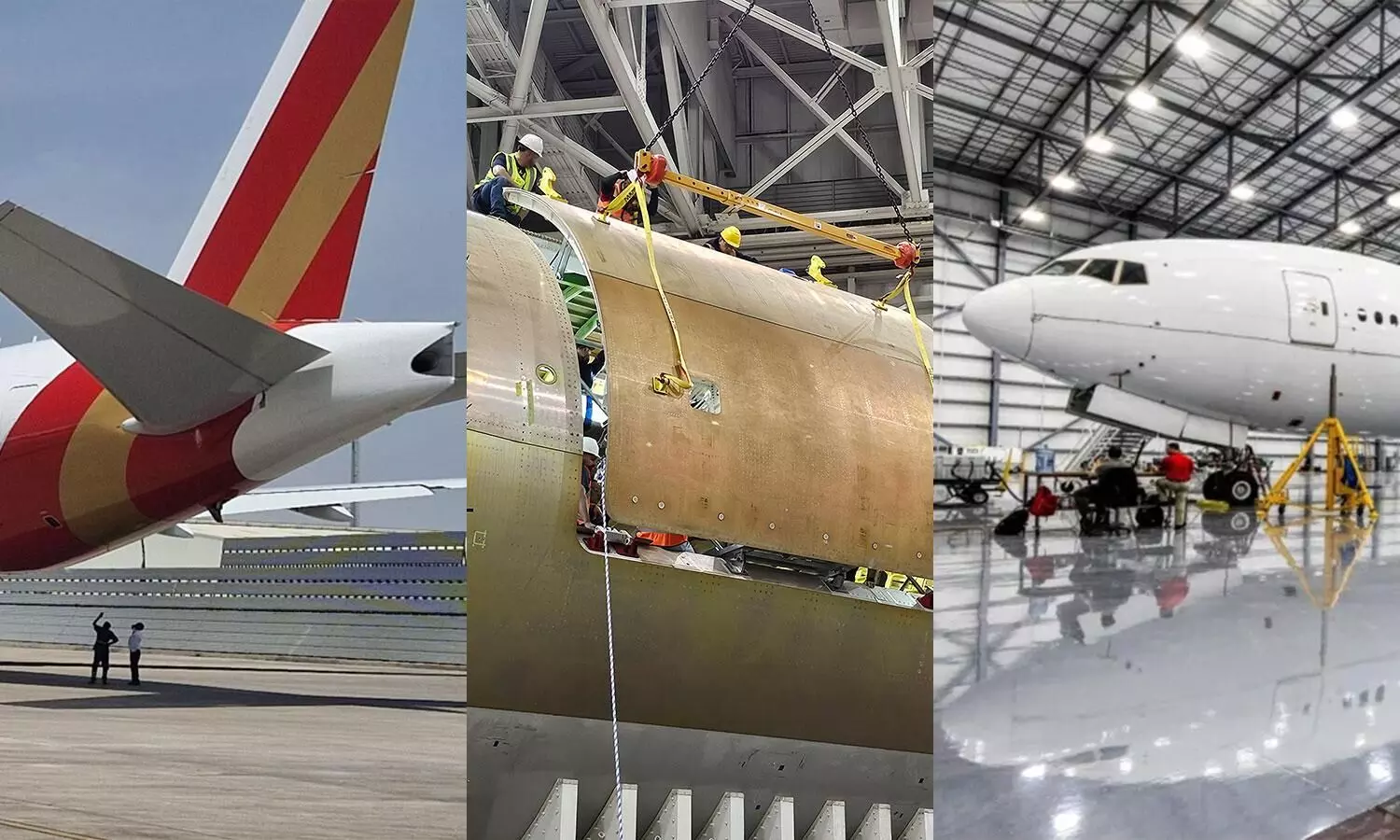
IAI, Mammoth, and KMC push ahead with Boeing 777-300ER freighters
IAI, Mammoth, and KMC are progressing with Boeing 777-300ER freighter conversions, but the lack of an FAA STC is delaying their aircraft's market entry. All three companies have provided updates on their freighter conversion programmes to The STAT Trade Times, with IAI expected to receive ICAA and FAA STC approvals by early May 2025. They are also making significant progress, attracting orders, and ramping up conversion capacity to address growing demand.

The three most significant freighter conversion programmes for the Boeing 777-300ER have been undertaken by Israel Aerospace Industries (IAI), Mammoth Freighters, and Kansas Modification Center (KMC).
However, none of these programmes have received Supplemental Type Certificate (STC) yet. Israel Aerospace Industries (IAI) is expected to be the first to obtain the STC from the Israel Civil Aviation Authority (ICAA) and the Federal Aviation Administration (FAA) at the beginning of May 2025.
In an exclusive statement to The STAT Trade Times, spokespersons from all three companies shared key updates on their freighter conversion programmes, offering insights into their progress, development milestones, and the latest on STC.
Advancements in IAI’s B777-300ERSF conversion programme
IAI's Boeing 777-300ERSF programme, known as ‘The Big Twin,’ was launched in 2019 in partnership with AerCap, with Kalitta Air as the launch customer.
According to IAI, at a freight density of 7.0 lb/cu ft, the Boeing 777-300ERSF can carry 18 tonnes more than the Boeing 777F and nine tonnes more than the Boeing 747-400BCF.
The IAI spokesperson stated that the company has secured over 60 orders and commitments from major global cargo operators and leasing companies. AerCap, the launch customer, will be the first to receive the B777-300ERSF, with initial deliveries set during 2025.
Discussing the next milestone in the programme and progress on STC, the spokesperson stated, “We already completed our certification programme including with the FAA team together. We are expecting to get the Israel Civil Aviation Authority (ICAA) and FAA STC at the beginning of May 2025.”
Recently, Japan Airlines (JAL) and Kalitta Air announced a codeshare agreement for regular cargo flights on the Narita-Chicago route, set to begin on May 10, 2025. This comes after JAL resumed freighter operations in February 2024 for the first time in 13 years. While from April 4 to 26, cargo space will be provided on flights operated by Kalitta Air using a 747-400F, from May 10, the codeshare will feature Kalitta Air operating flights with the new B777-300ERSF.
The Big Twin of IAI in Kalitta Air livery
“Several aircraft have already been converted and will enter operation once the FAA STC is granted. Following certification, we will expand production capabilities to additional external conversion sites (South Korea, Abu Dhabi, USA, and at IAI), ensuring scalability and meeting the growing demand for the 777-300ERSF conversions. Furthermore, we will optimise production efficiency and streamline the conversion process to meet projected delivery schedules. Our long-term strategy includes investing in process improvements, developing automation in key conversion stages, and ensuring that we can meet market demand efficiently.”
The spokesperson also highlighted IAI’s other conversion programmes, stating that the company continues to lead the global passenger-to-freighter (P2F) market, driven by strong demand for its B737-800BDSF and B767-300BDSF programmes. The B767-300 conversion remains a key part of IAI’s portfolio, with growing demand due to its efficiency in the mid-size freighter segment. Additionally, the A330-300 P2F programme is currently in development, with an aircraft undergoing conversion in the hangar.
Regarding upcoming projects, including the Boeing 787 conversion programme, the spokesperson stated that the programme is currently in the preliminary feasibility study phase.
Notably, Emirates SkyCargo, the cargo division of Emirates, partnered with IAI in 2021. The initial agreement included the conversion of four Emirates Boeing 777-300ER aircraft into freighters but this was later expanded to 10 conversions. The aircraft were to be converted at IAI’s facility within Etihad Engineering’s MRO centre in Abu Dhabi. The original conversion for the first four aircraft was expected to begin in early 2023 however, as of now, Emirates SkyCargo has not yet received any Boeing 777-300ERSF from IAI.
During the seventh edition of Air Cargo Africa, held recently in Nairobi, Emirates SkyCargo's Divisional Senior Vice President, Badr Abbas discussed their initial plans to convert the Boeing 777-300ER into a freighter. He stated that while their partner, IAI, is currently facing technical delays, the converted freighter will offer operational advantages along with large and flexible capacity. This will enable Emirates SkyCargo to efficiently handle high-volume shipments, particularly for e-commerce.
However, in the meantime, he mentioned that the company has placed an order for 10 Boeing 777 freighters with Boeing, scheduled for delivery between 2025 and 2026. The goal is to have a total of 21 freighters by the end of December 2026.
A deep dive into Mammoth Freighter’s P2F programme
Mammoth currently offers conversions for two Boeing 777 models, the LR and the ER. The company states that its main deck side door is larger than those on the 747-400F, 767-300, original equipment manufacturer (OEM) 777 freighter, and all other competing 777 conversion products.
The B777-200LRMF has a maximum gross payload capacity of 233,000 lb (105,687 kg) and a maximum takeoff weight (MTOW) of 766,000 lb (347,452 kg).
While the B777-300ERMF has a maximum gross payload capacity of 216,000 lb (97,976 kg) and a maximum takeoff weight (MTOW) of 775,000 lb (351,534 kg).
In a statement to The STAT Trade Times, Brian McCarthy, VP of Marketing & Sales, Mammoth Freighters, provided an update on the programme, stating: “Mammoth is nearing the completion of its prototype 777-200ER conversion and making significant progress on the 777-300ER. The company has reached steady-state production for main cargo doors and surround assemblies, with the first cargo door for the 777-300ER recently installed on the prototype aircraft for Avia Solutions Group. Currently, five 777 aircraft are being converted at Mammoth’s Fort Worth, Texas, MRO facility (Aspire), with two more at STS in Manchester, UK.
All major cargo doors and surrounding structures are assembled at Mammoth’s Fort Worth facility, which has the capacity to produce over 20 such structures annually. The company has secured 35 firm orders for both 777-200LR and 777-300ER variants, with ongoing discussions for additional orders following certification.
Mammoth is conducting this certification with the FAA under one project number, whereby the 200LR will be considered the master STC with the 300ER STC issued under amendment. Jetran is the launch customer for the 777-200LR, with DHL set to operate 11 of these aircraft. Avia Solutions Group (Avia AM Leasing) is the launch customer for the 777-300ER, with its Air Operator Certificate (AOC), BBN Istanbul, preparing to begin operations with the first of six aircraft later this year.”
Discussing the STC, he said “We are not making any precise forecasts or predictions for certification until we complete our company and formal test flights. We hope to be in the air in late Q1 or early Q2 of 2025.
Certification of any wide-body fleet type can be considered a daunting task. Today’s regulatory authorities have never been more thorough and focused and the bar has never been higher.
Mammoth Freighters remains confident in the process and has the finest team ever assembled to engineer, produce, and achieve certification of this fleet type. Our confidence in completing this process is evidenced with 7 aircraft deep in the process. This was done consciously because we intend to capture a significant portion of the market with what we consider to be a ‘best in class’ conversion.”
While giving an update on the programme, McCarthy said “Noise testing is one of several test plans that was completed recently. Mammoth has already started numerous ground tests as it prepares for flight, initially with the 200LR.
Mammoth & Aspire MRO install main cargo door on 777-300ERMF
From an avionics, flight deck, systems, hydraulic, pneumatic, and structural view, the 200LR and 300ER are extremely close 'cousins" because they share the same engine, pylon, wing, gear, flight deck, etc.
Further, Mammoth's conversion-related systems structure, supernumerary compartment, rigid cargo barrier (RCB), cargo loading system, and main deck cargo door/ surround areas are nearly identical for these two fleet types. Aside from a tremendous amount of loads engineering and analytical substantiation required to certify the 300ER, these two fleet types have few differences other than the most obvious being 33 feet (10 metres) of additional fuselage structure and volume.”
“Mammoths conversion will soon be compatible with both large and small ‘lower hold’ aft cargo door variants. The first of three Ex-Air India 200LRs scheduled for conversion will be the conformity for this STC amendment. The small doors of 777's are considered ideal for temperature and security-sensitive cargo such as pharmaceuticals. By the time Mammoth achieves certification, it should have 5 or 6 aircraft completed and ready for delivery,” he added.
How is KMC’s B777-300ERCF programme progressing?
Unlike Mammoth and IAI’s B777 freighters, which feature a main cargo door at the rear, Kansas Modification Center’s (KMC) B777-300ERCF is designed with a forward main cargo door.
The B777-300ERCF has a maximum gross payload capacity of 205,000 lb (92,986 kg) and a maximum takeoff weight (MTOW) of 775,000 lb (351,534 kg).
Jim Gibbs, President of KMC, told The STAT Trade Times that the company is making steady progress on the conversion, with a strong focus on the certification process.
He stated that KMC currently has orders for 10 aircraft through Backbone Freighter Leasing, a division of Dr. Peters Group, with the rollout planned for this year and certification expected in the second quarter of 2026.
Gibbs added, “Certification is on track with the FAA. We have been working closely with the certification bodies and have approved plans and a clear path on all aspects of the certification.”
Addressing concerns about potential issues with the STC certification programme and any resulting delays, Gibbs stated, “The new regulations concerning the fatigue and damage tolerance analysis have been very difficult, but we now have an FAA-approved plan and are complete with the premodification testing.”
KMC's conversion of the B777-300ER aircraft
Notably, American aircraft manufacturer Boeing has likely concluded the production of its best-selling long-haul wide-body airliner, the B777-300ER. The final B777-300ER was delivered to Ethiopian Airlines, marking the end of nearly two decades of production. Production quietly ended in 2024, with only one aircraft delivered in its final year.
While production of the B777-300ER passenger variant may have ended, Boeing remains focused on the B777X programme. However, the manufacturer has no plans to discontinue production of the B777F freighter variant as of now. The B777F is expected to remain in production and operation, supported by a strong unfilled order book of 73 aircraft as of February 28, 2025, according to Boeing data. Notably, in January, Boeing received orders for two B777Fs from unidentified customers. This seems to provide positive momentum for the manufacturer, at least until the next-generation B777-8F freighter enters service, which is expected in 2028. Meanwhile, FedEx has also finalised agreements to acquire eight new B777Fs and two used 777Fs, with deliveries scheduled for 2026 and 2027.
The B777-300ER remains a strong contender in the freighter segment. With a length of 73.9 meters (242 feet 4 inches), it offers more cargo space than Boeing’s current production freighter, the B777F, which is based on the B777-200LR and measures 63.7 meters (208.99 feet) in length. This makes the B777-300ER an attractive option for conversion into a freighter.

